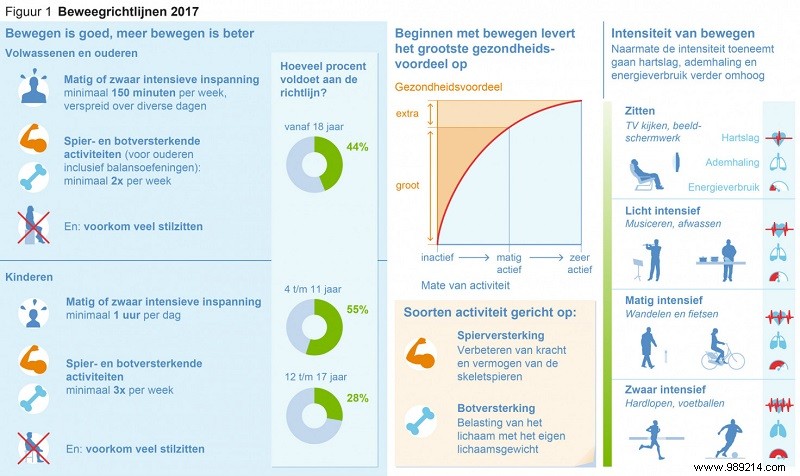According to the new guidelines of the Health Council, adults should exercise at least two and a half hours of moderate intensity every week and children at least one hour a day. Muscle and bone strengthening activities are also recommended for both groups. All of this lowers the risk of chronic diseases such as diabetes, cardiovascular disease, and depressive symptoms and, in the elderly, bone fractures.
There are three standards for exercise in the Netherlands:the Dutch Standard for Healthy Exercise, which recommends moderately intensive exercise for at least half an hour on at least five days a week, for example by walking briskly; the Fitnorm, which indicates that you exercise vigorously for at least twenty minutes on at least three days a week, for example by running; and the Combinorm, for which you must meet the Exercise Norm and/or Fit Norm.
In deriving the new exercise guidelines, first the research into the effect of exercise and sitting on the risk of chronic diseases and physical disabilities (elderly) and on fitness (children) was systematically assessed in two background documents. Different levels of evidential value are assigned here. Subsequently, it took effects with a high evidential value as the starting point for the derivation of the guidelines, whereby it also took into account existing international guidelines.
The large number of beneficial effects of regular exercise is reaffirmed in this advice. Exercise is healthy for all age groups. This concerns both activities aimed at endurance and strength (muscle strengthening). In adults and the elderly, exercise reduces the risk of cardiovascular disease, diabetes and depressive symptoms. Furthermore, a lot of exercise is associated with a lower risk of breast and colon cancer and premature death. Research shows that the beneficial effects increase as the amount of exercise increases. Relatively speaking, most health benefits are achieved by becoming physically inactive (at least moderately intensive). In the elderly, exercise also lowers the risk of bone fractures and improves muscle strength and walking speed. Exercising in this group is also associated with a lower risk of physical disabilities, cognitive decline and dementia. In children, exercise also lowers the risk of depressive symptoms, improves insulin sensitivity and bone quality and – in overweight and obese children – lowers body mass index and fat mass. Furthermore, exercise improves fitness and muscle strength.
On the other hand, sitting a lot seems unfavorable for health:sitting a lot is associated with a higher risk of cardiovascular disease and premature death. However, the association becomes weaker the more people exercise and is not present in people who exercise a lot (well above the current exercise standard). The scientific basis for the health effects of sitting is currently much less strong than for exercise.
The exercise guideline for adults and the elderly is as follows:
* Exercise is good, more exercise is better.
* Do at least 150 minutes a week of moderately intensive exercise, such as walking and cycling, spread over several days. Moving longer, more often and/or more intensively provides additional health benefits.
* Do muscle and bone-strengthening activities at least twice a week, combined with balance exercises for the elderly.
* And:avoid sitting still.
The following exercise guideline applies to children aged four to eighteen:
* Exercise is good, more exercise is better.
* Do at least an hour of moderately intensive exercise every day. Moving longer, more often and/or more intensively provides additional health benefits.
* Do muscle and bone-strengthening activities at least three times a week.
* And:avoid sitting still.
